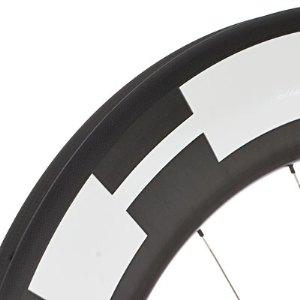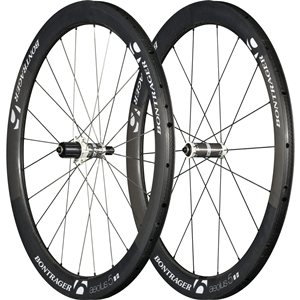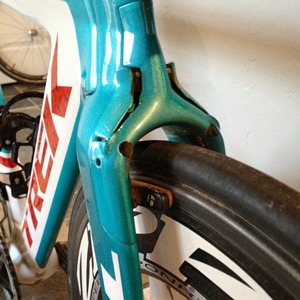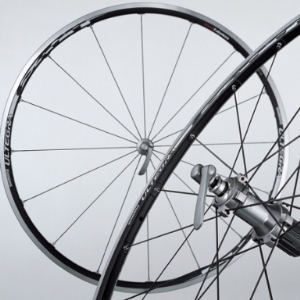Implications of Rim Width

There is a trend in today’s road and triathlon wheels – they’re getting fat. What’s the reason behind this seemingly unstoppable expansion of girth? Depending on who you ask, there are many benefits from using wider rims. First and foremost, you can use a wider tire at little-to-no aerodynamic penalty. When the rim’s width more closely matches your tire’s width, the airflow around this system tends to be smoother than the lightbulb shape of a wide tire and narrow rim.
But why would you want to use a wider tire? For starters, they reduce your risk of pinch flatting at a given tire pressure. As well, you can use a lower air pressure which absorbs more road shock, and tends to have a reduced Coefficient of Rolling Resistance (Crr). For those not in-the-know, Crr is like a golf score – lower is better (and faster). Lastly, wider tires tend to have better grip on wet or irregular road surfaces. Gone are the days of road racers using 21mm tires at 150 psi (10 bar) for everyday usage. By 2012, we’ve seen nearly a universal adoption of 23 and 25mm tires by the Pro Peloton, at pressures ranging from roughly 90 to 115 pounds. For the cobbled Spring Classics races, they often use up-to-28mm tires and even lower pressure.
On to the more subjective benefits of wide rims, some say they improve handling or cornering, due to the resulting casing shape of the tire. There is also a loosely thrown-around idea that wider rims unilaterally reduce rolling resistance – in and of themselves. At this time, I say the jury is out; nobody seems to be able to back it up with real numbers. For example, suppose you have a 23mm tire. You mount this tire on both a 19mm wide and 23mm wide rim. Your tire’s contact patch on the 19mm rim is long and narrow, and with the 23mm rim is short and wide (relatively). The wider rim increases air volume slightly, and makes the tire’s sidewalls more vertical. In theory, the tire casing has to deflect less to make the same size contact patch – easy enough.
Does that automatically mean that the Crr is lower? Some manufacturers suggest that this is the case, but nobody is producing hard numbers to prove it – or at least showing them to any of us. Zipp Technical Director, Josh Poertner, challenges the idea. He suggests that there may be a very, very small improvement – but neither their testing, nor any independent testing they’ve seen can prove it outside of the margin of error of the test (on the order of .0000125 Crr improvement). My suggestion is that saying that the wide rim itself improves Crr, is like claiming that the chicken came first, when it’s really the egg. Yes, a wide rim allows you to run a wider tire and lower pressure – which lead to lower Crr. But it isn’t the rim itself that lends to this improvement; or at least not enough that we can actually measure it. I’ll go ahead and insert the voice of reason for you: Go worry about something else! Sleep more! Eat less Twinkies!

ETRT-Who?
Now that we understand the theory behind it, how do we go about measuring our rims? In tubular rims, you can only measure outside-to-outside at the braking surface. With clinchers, however, you have the ETRTO (European Tire and Rim Technical Organization) internal width, as well as the outside-to-outside measure.
The part that really matters is the ETRTO – this is what determines how wide the tire casing spreads. That measurement generally correlates to an outside-to-outside rim measurement, but it can vary. For example, a narrow 13c clincher rim measures 13mm on the inside walls. This generally correlates to an outside width of 18.5-19.5mm, but it varies depending on manufacturer and rim wall thickness. An “average” road rim used to be a 13c or 15c, and many of the new wide rims are 17c. A 17c rim generally lends to an outside measurement of about 23mm.
Keep in mind that – at least with clincher rims – there is a specific range of tire sizes that you can “get away with” for a given rim size. Go with a tire that is too wide for your rim, and it can feel excessively squirmy while cornering, especially at lower air pressure. Go with a rim that is too wide for your tire, and you run a real safety hazard – at some point those tire beds won’t stay seated (for example, if you try to use a 20mm tire on a 30mm rim).
Our friends at Schwalbe were kind enough to lend us this ETRTO graphic, showing the ranges of tire size that is recommended for each rim size.

Note that there is a distinct cutoff that we should all be concerned with – between 15c and 17c rims. As mentioned, 15c tends to be on the wide-end of old traditional road rims. For example, the ubiquitous Mavic Open Pro is a 15c rim. According to the rules, the narrowest tire you should use with this is a 23mm. You will notice that many of the newer wide rim manufacturers fail to mention the ETRTO size; they only tell you the outside-to-outside measurement of the rim. I can tell you with a high level of certainty that any 23mm wide rim is at least 17c ETRTO. Most of these rim manufacturers recommend a minimum of a 23mm tire… but that technically doesn’t fit the chart…>insert screeching halt<
Huh?! Are you at a risk of system failure, and perhaps a crash? The late bicycle genius, Sheldon Brown, suggested that the ETRTO chart is on the conservative side in its prescriptions. It is common knowledge in the mountain bike world that you can get away with a much wider tire than recommended. We also know that folks have used 18-20mm tires for years on many standard rims, including the technically-too-wide 15c standard. What does this all really mean?
The real take-home is that we should all educate ourselves on the topic, and understand that if we choose to go outside of the standards, it is at-your-own risk. As well, we should continue to push manufacturers for full-disclosure of their rim ETRTO sizes. Perhaps they will tell you if you call them up, but none currently publish this information of their new wide clincher rims. While I wouldn’t recommend using anything less than a 23mm tire on a rim that is ETRTO 17c (or 23mm outside-to-outside), it appears that many people are using this combination today without issue.
For tubular users, the good news is that this whole discussion is essentially out the window. By nature of the physical connection of tire and rim, tubular tire size doesn’t matter nearly as much when it comes to this width safety concern. Run a 22mm tubular tire on a 27 or 28mm wide rim if you like. Plenty of people do this today by pairing, say, a Continental Competition tire with a Hed Stinger 5 or Reynolds RZR 92.
Bike Considerations
You may not realize it, but your bike choice can also highly influence your wheel choice – or at least it should. In part for aerodynamic considerations, but also mechanical. Pretend, for example, that you ride a new Felt DA. This is a fantastic bike, but we’ll be the first to admit that the rear brake is not as user-friendly as a standard road caliper brake. If you train on a rim that is 19mm wide, but race on a rim that is 26mm wide, that means you’ll have to do some major brake adjustments when swapping wheels. This being the case, I am of the opinion that you ought to have training wheels and racing wheels that are of same or similar width. If you’ve got narrow, stay narrow… if you’ve got wide, stay wide. If you can get them within, say, .5mm of each other, you probably won’t have to do any width adjustment on the caliper.

If you want to take it one step further, you can even choose training and racing wheels that have the same brake surface material, so you can avoid swapping between aluminum and carbon-specific pads.
Being a savvy triathlete, you may choose to train on the Hed Ardennes, and race on their Jet series. Both are 23mm wide and have aluminum braking surfaces. Or – if carbon is your flavor and budget is no object, you can make like Linsey Corbin – she is lucky enough to train on Zipp 404 Firecrest carbon clinchers, and race with the 808 front Firecrest and Super-9 disc (all with Powertap hubs). All are similar width, minimizing brake adjustments on her Trek Speed Concept. Her bike is pictured here, taken after the 2012 edition of Wildflower. The slick modern tri frames are certainly full of technology and speed, but admittedly at the cost of some mechanical simplicity. Thankfully you also have two micro-adjustable TT brake levers options from Bontrager or SRAM to help fine-tune your brake width on such frames.
And what about the really wide rims, such as Zipp’s 303 Firecrest, or the bulk of the Hed Stinger line? These rims feature brake tracks as wide as 28mm; there exists not a single training wheel this wide. About the best you can do is a 19c touring-style rim (such as the DT Swiss TK series or Mavic A719), which measure about 24mm on the outside. But – these require a 28mm tire according to ETRTO standards, which won’t fit in many modern tri bike frames. What’s a triathlete to do? The only real option is to get the widest training wheel you can find, and then shave your brake pads accordingly to minimize adjustments (shave down your carbon race pads to ~60-80% of their original width, and keep your aluminum training brake pads at full size). Or just deal with the fact that you have to adjust the brakes. Given your bike choice, this could mean removing cranks and spending half your afternoon tinkering. That’s fine if you’ve got the time – but if not, consider this your warning.
The final snafu that must be noted is the fact that, for the most part, rim widths are all over the map. And we have another problem that nobody seems to measure them the same way. Some rims have parallel brake surfaces, and some are curved. Most are measured from the middle of the brake track, but Zipp gives you the measurement at both the top and bottom edge. Bontrager and Enve both say that their curved braking surfaces aren’t angled enough to really affect your measurement, so they stick with the middle. You’ll find that even within a single manufacturer’s line-up, almost no one has standardized width. Harrumph! Bah, Humbug!
This doesn’t necessarily mean we should all take issue with them. Changes take time. Some manufacturers, such as Reynolds and Mavic, both expressed serious commitment to aerodynamic development in the future. I’d venture a guess that we’ll see their rim width and shape continue to evolve. The basic realities of business dictate, however, that these changes cannot happen overnight – at least not to an entire product line.
Below we offer a listing of Everything-We-Know-Of-Rim-Widths for 2012. All measurements are manufacturer-provided, so don’t kill the messenger if your Vernier caliper measures .01 wider than advertised. We want to give you the opportunity to at least get in the ballpark on rim width, to make your life easier. Drum roll please…




